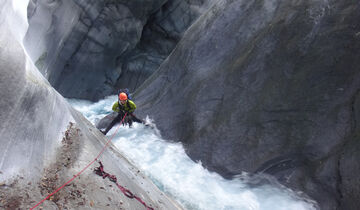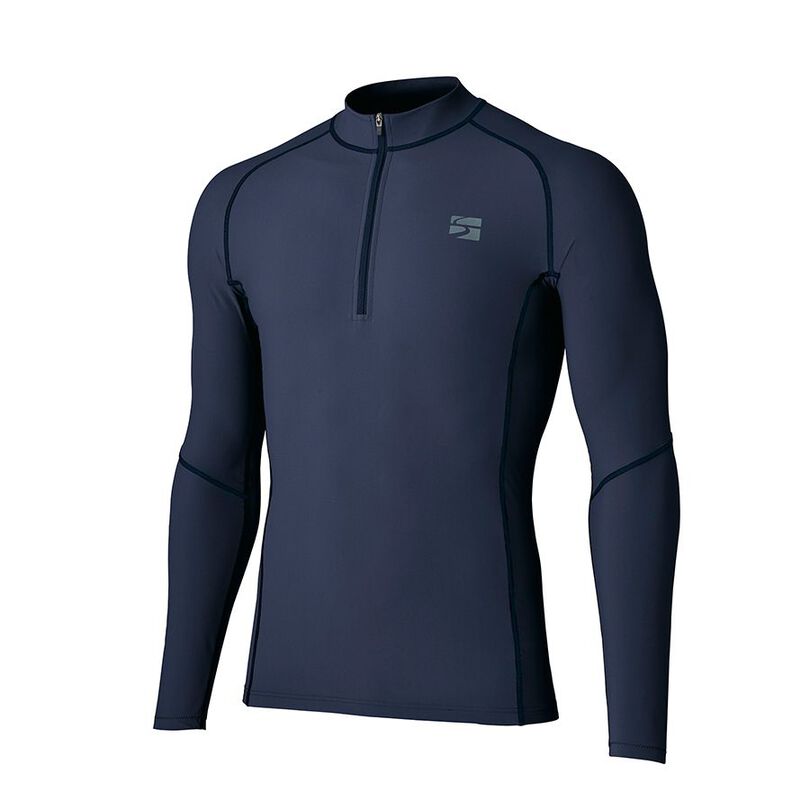Finetrack staff activity blog
For everyone here at Finetrack, outdoor sports is deeply integrated into our everyday lives. We long to spend time in places where we can fully immerse in nature and give in to the experience and beauty of it all. We find that through the joys of these moments, we are able to derive inspiration and innovative ideas for our products.
Posted by: Sou Aikawa
This time, we are a group of six: four members from Japan and two from Taiwan. We planned a nine-day trip, with seven days in the canyon and two additional days as a buffer.
On the afternoon of November 12th, we’ll meet at a hostel in Taipei for a meet-and-greet, gear check, and supply organization. After shopping for provisions, we’ll depart from Taipei early the next morning on the 13th.
Our climb will begin from behind the school in Sanzhan village, starting close to sea level, around 0 meters.

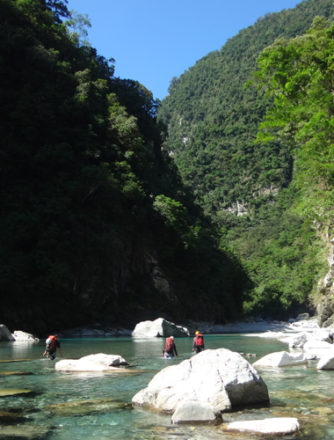
The beginning part of the route consists of riverbanks.
In many canyons in Taiwan, the water near the lower reaches tends to be murky, but here the water is incredibly clear. The route begins by following along the riverbanks, with beautiful pools appearing occasionally, creating a soothing experience. The high transparency of the water alone is enough to lift our spirits.
November 13:
I thought the first day would pass without any major challenges, but toward the end, we started encountering a series of swims.


At the very end, we encountered a slightly challenging section.
Here, Wang, one of the Taiwanese members, displayed an impressive swim, reaching the waterfall and successfully climbing it. I was gradually realizing just how skilled Wang is at swimming—not only is his strength remarkable, but his ability to read the water current is exceptional. As it turns out, his mother was a swimming instructor who trained diving instructors and others, so he's been a pro since childhood. He mentioned being thrown into rough seas to hone his skills from a young age… definitely a reliable team member!
November 14:
Right from the start, we spotted a dangerous waterfall ahead, beyond a long pool of water.

We swam through the deep blue pool, so deep that the bottom was out of sight, in three hard pitches. After that, we gathered directly below the waterfall.

If we could cross the current successfully, the left side seemed relatively easy to climb. However, crossing that current felt like a suicidal move...
After much deliberation, we decided to place two bolts on the right wall and used aid climbing to get through.

The next waterfall was skillfully tackled by following the waterline on the right.
Everyone edged along the rock face, and from there, the canyon continued with alternating sections of swimming and climbing. Due to the strong current, the lead swimmer had to cross without gear and pull the rest of the team across each time.
We hadn’t made much progress, but before we knew it, the afternoon had already arrived.

Then we encountered a 3-meter waterfall with a large pool below. The current was so strong that, even with Wang’s swimming skills, it was impossible to approach.
Looking around, I spotted a ledge about 40 to 50 meters above the pool, which seemed to provide a way down the waterfall. However, reaching that ledge required an additional 50-meter rappel from above. It felt daunting, but we had no choice but to go for it.

As dusk approached, we successfully reached the targeted ledge after two rappels from a cleverly chosen point that seemed like our only option. After three hours of navigating around obstacles, evening had already arrived. This was... quite challenging.
The Taiwanese members of our group had experience with the initial section of the canyon, and it seemed that the water level was significantly higher this time. They suggested this could be due to the unusually high number of typhoons in September and October, along with the water-absorbing characteristics of the limestone geology.


November 15:
The cliffs on both sides rose high, and the scale of the canyon grew grander. Ahead of us was a massive wall towering around 500 meters, which we would have to navigate beneath.
After passing a large tributary, we entered a series of intermittent gorges. Although not very tall, many of the waterfalls required challenging swimming and climbing, testing our team’s strength in overcoming each obstacle and hauling our gear. That said, this is the essence of the gorge, and devising strategies to tackle it is the fun part.
This was also a challenging point. The current was very strong, so the lead climber established a belay point in one spot while breaking through. The rest of the members were pulled directly by the rope.


The next pool was impossible to cross by swimming, but we found a way forward along the right wall. The slab beyond it was also quite tricky.
We continued swimming relentlessly and eventually reached the source stream.

A giant boulder, about the size of a house, jutted out right in the middle of the current.
Boulders of this size are quite common here.

A pool that resembles a gate. I was surprised to find remnants of something like a raft used by indigenous people. Occasionally, we come across such artifacts.
It seems that indigenous hunters don’t follow canyoning routes but instead navigate their own paths through the forest without specialized gear, descending to their established camps along the stream. If they were equipped with the latest gear, they might become the strongest canyoners around!

This was our campsite for the third day. We were fortunate with both the campsite and the weather. However, we still couldn’t reach our intended destination that day, and I could feel our schedule tightening.

November 16:
Right from the start, we encountered a massive rock shelter where indigenous hunters had set up camp. Wang advised us not to take photos, so I kept my camera away. But as we approached, I noticed one of the hunters holding a GoPro, and the women in our group were being interviewed.
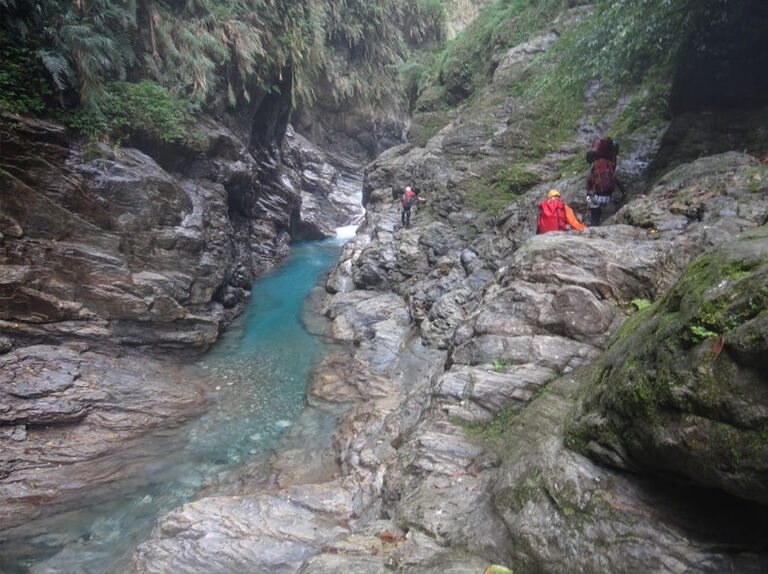
The waterway gorge begins where a large tributary enters.
Fortunately, we were able to traverse the entire gorge along the left bank and make our way through.
Eventually, the view opened up significantly, revealing a space enclosed by crumbling walls. The marbled patterns in the limestone were beautiful.

From here, a gorge of an entirely different scale began—it was like a crack in the earth.
The intricately eroded marble sidewalls rose beyond vertical, making it impossible to traverse around them. We had no choice but to push straight through.



In the beginning, our focus was mainly on swimming. After crossing the tributary, the water current noticeably weakened, allowing everyone to swim through most pools without needing a rope.
However, as the gorge gradually narrowed to about 2 meters in width, the water's momentum began to increase accordingly.
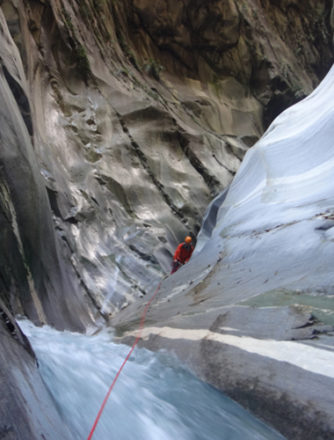
This marked the true beginning of our journey’s core. First, we encountered a powerful, funnel-shaped waterway.
We managed to break through using just enough stemming.

However, just ahead was a very challenging 4-meter waterfall with a large pool below. I was at the back, so I didn’t see it directly, but I heard that even with Wang’s swimming skills, it was impossible to approach.
It was clear that once we got past this waterfall, we would be through with the gorge!

We had no choice but to retreat back to the entrance of the gorge.
We needed to withdraw from the intimidating funnel-shaped section we had barely managed to cross. Descending with all our gear was extremely difficult, so we decided that one person would go ahead without any gear, securing bolts at key points to set up a fixed rope.
It was challenging, as I got caught in the swirling current of the pool where the funnel-shaped flow converged, but somehow, I managed to complete the setup.

Once the second person descended, we executed a plan to send our gear down first, with someone waiting downstream to catch it.
The last person to descend was swept away and had to be recovered downstream, but fortunately, everyone managed to retreat safely.
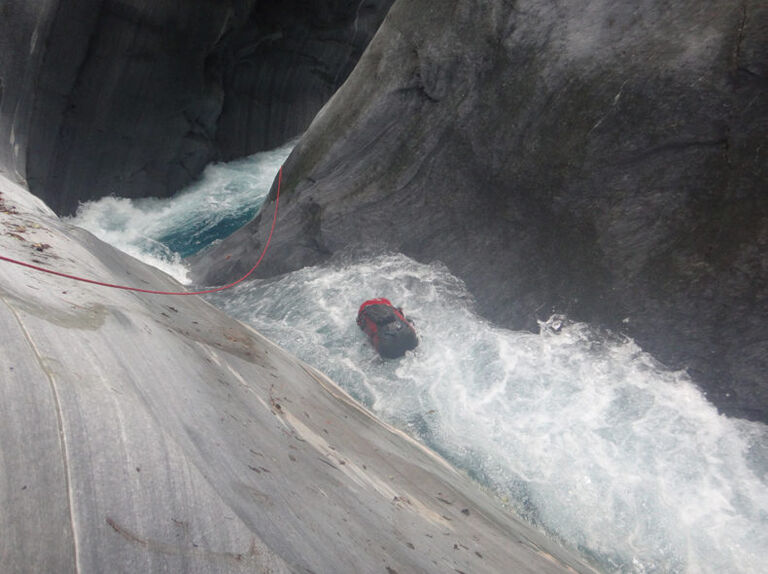

"We really did it, didn't we?"
That night, we gathered around the campfire, sharing and reflecting on our experiences.

Given the water volume and our pace, it was clear we would run out of time. The safest option would be to descend the same route we came up. However, since we came all the way here, we decided to take a more interesting route instead.
Our plan was to bypass the large gorge where we had previously retreated, follow a unique, gentle ridge beyond it, and then trace the source of a tributary along the way, aiming to exit into Taroko.
November 17:
We began a full day dedicated to bypassing the large gorge. Although we called it a bypass, it felt more like climbing over a massive ridge. First, we had to make an endless climb up a steep scree slope.
Navigating through a thicket of vicious thorny plants was a challenge, but we eventually made it to the ridge, where the terrain became quite comfortable.

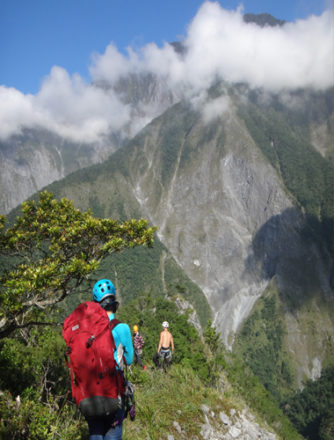
The thorny plants here are far more vicious than those in Japan.
After completing the bypass, we went to inspect the endpoint of the gorge. It was immediately clear that continuing from there was impossible, and we all accepted that reality.


We made some progress further along before wrapping up for the day. When we reached the sandy patch we had marked during our descent, it proved to be an excellent bivouac site—worthy of the name "Hotel Sanjian Creek." We enjoyed our final night along the main stream.

The ridge we had marked as our escape route turned out to be a fortunate choice, with moderate underbrush and no challenging sections. It was much more manageable than we had expected.
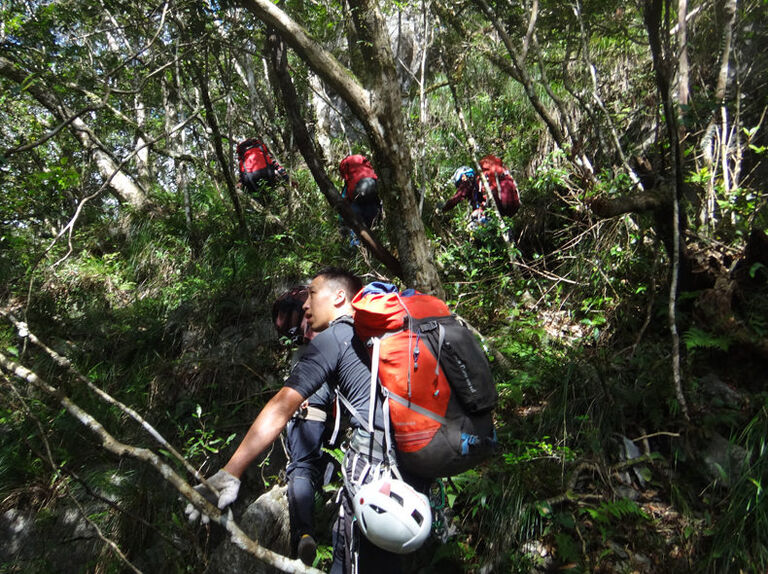
After gaining about 1,100 meters in elevation along the ridge, we navigated through a tricky section before descending into the left-hand stream.
To our surprise, however, the stream had no water at all! Since it was a limestone creek, we had somewhat anticipated this, but I had optimistically hoped to find at least a few spots with water. Instead, it was completely dry, and we resorted to drinking from the small puddles that remained.


Just as panic was beginning to set in, we stumbled upon a large, tannin-rich puddle. After boiling the water to make it safe, we were able to drink and get through the night.
Our bivouac site in the jungle would have been quite comfortable—if only there had been water.

November 19:
Although we had escaped the stream, we still faced a solid two days of descent. The traverse through a magnificent forest of giant trees—many comparable to Yakushima cedars—was quite enjoyable. We reached the summit of Zhugu Mountain, standing at 2,500 meters, though it’s considered a low mountain in Taiwan, and few people seem to know about it.

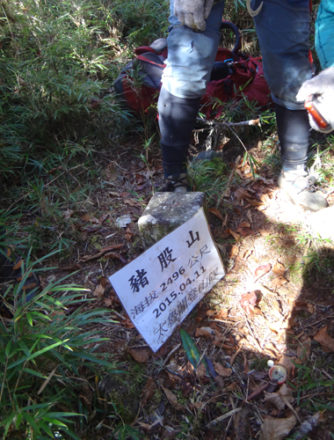
November 20th:
We reached the final peak, Jiangku Mountain.


We descended 2,000 meters and made our way down to Taroko. After the descent, we washed off the sweat in a rugged hot spring right next to the raging river.
"Thank you for your hard work!"
Although we couldn’t follow our target line this time, we gave it our all, and given the conditions and schedule, this was our best effort. With each passing day, we became tighter as a team, making this a truly enjoyable expedition.

Even in tropical Taiwan, it can get quite cold in November. Although we didn’t venture to particularly high altitudes this time, once you exceed 2,500 meters, things can freeze in the morning. In such conditions, with frequent swimming in streams, I used a three-layer water layering system with the Elemental Layer Warm®, Rapid Rush®, and Flood Rush®. When swimming, I added an outer layer, which was enough to handle everything.
With this layering, I could dry off almost completely by the campfire at night, so I didn’t need to change clothes. I managed to go eight days without changing, and my emergency dry undergarments remained untouched until after we descended.
